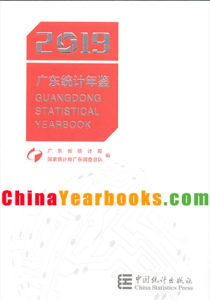Guangdong Statistical Yearbook 2019 Download
Yearbook title:广东统计年鉴2019
Yearbook English title:Guangdong Statistical Yearbook 2019
Published Date :10/2019
Language : English and Chinese bilingual
Availability : Printed Version;Electronic Version(CD Version,PDF Version)

Ⅰ.Guangdong Statistical Yearbook 2019 (hereinafter referred to as the Yearbook) is an annual statistical publication, which reflects comprehensively the economic and social development of Guangdong Province. It covers data for 2018 and key statistical data in some historically important years since 1978 at the provincial level and the local levels of city, county and district.
Ⅱ. The Yearbook contains twenty-two chapters: 1. General Survey; 2. National Accounts; 3. Population; 4. Employment and Wages; 5. Investment in Fixed Assets; 6. Foreign Trade and Economic Cooperation ; 7. Energy, Resources and Environment ; 8. Government Finance, Banking and Insurance; 9. Prices; 10. People’s Living Conditions; 11. Agriculture; 12. Industry; 13. Service Enterprises Above Designated Size;14.Construction; 15. Transport, Postal and Telecommunication Services; 16. Wholesale , Retail Trades and Tourism; 17. Hotels, Catering Services and Tourism; 18. Education, Science and Technology; 19 Culture and Sports. 20.Public Health, Social Welfare, Social Insurance and Others; 21. Main Economic Indicators of Economic Regions; 22. Main Economic Indicators of Counties (County-level Cities) and Districts. Meanwhile, four chapters are listed as appendices: 1. Main Statistical Indicators of 31 Provinces and Municipalities; 2. Main Statistics of Hong Kong and Macao Special Administrative Regions; 3. Main Statistical Indicators of Taiwan Province; 4. Main Statistics of Some Countries and Territories. To facilitate readers, the Brief Introduction at the beginning of each chapter provides a summary of the main contents of the chapter, data sources, statistical scope, statistical methods and historical changes. At the end of each chapter, Explanatory Notes on Main Statistical Indicators are included.
Ⅲ. The data in the Yearbook are mainly obtained from regular statistical reports and sample surveys conducted by the statistical bureaus of all levels of government and the Survey Office of the National Bureau of Statistics in Guangdong. Some data are collected from the departments of the central government and the provincial government. Data in the appendices are compiled from statistical publications published by the National Bureau of Statistics and other sources.
Ⅳ. The pearl river delta, east wing, west wing and mountainous areas in the Yearbook are divided as following:
The pearl river delta include Guangzhou, Shenzhen, Zhuhai, Foshan, Jiangmen, Dongguan, Zhongshan, Huizhou and Zhaoqing.
The east wing includes Shantou, Shanwei, Chaozhou and Jieyang.
The west wing includes Zhanjiang, Maoming and Yangjiang.
The mountainous areas include Shaoguan, Heyuan, Meizhou, Qingyuan and Yunfu.
Ⅴ. The units of measurement used in the Yearbook are internationally standard measurement units, except that the unit of cultivated land and sown areas uses“mu” with regard to the Chinese tradition.
Ⅵ. Please refer to the newly published version of the Yearbook for updated historical data.Statistical discrepancies on totals and relative figures due to rounding are not adjusted in the Yearbook.
Ⅶ. Notations used in the Yearbook:
“ … ” indicates that the figure is not large enough to be measured with the smallest unit in the table;
“ # ” indicates a major breakdown of the total;
“ blank space ” indicates that the data are unknown or are not available;
“ ① ” indicates footnotes at the end of the table.
Ⅷ. In comparison with Guangdong Statistical Yearbook 2018,following revisions have been made in this new version in terms of the statistical contents and in editing: Of the chapter of “General Survey”, table of main economic and social indicators of Guangdong-Hong Kong-Marco Greater Bay Area is added. Of the chapter of “National Economic Account”, data about the development of new economy are added. Of the chapter of “Population”, table of basic statistics on National Population Censuses are added. Of the chapter of “Resources and Environment”, figures of water resource are listed separately, relevant table frames are adjusted. Of the chapter of “Foreign trade and Economic Cooperation”, data of direct investment in RMB that are approved by Ministry of Commerce are adopted. According to the new departmental reporting system, some professional contents and indicators have been adjusted.
Ⅸ.Because the result of the Fourth National Economic Census have not yet been released, data of 2018 in this Yearbook related to the census such as national account, industry, investment, construction, service above designated size, wholesale and retail sale and catering adopt the result of flash annual report. Some data that only could be collected with annual report are not offered for the present. The data based on the annual report of these industries will be reflected in the Yearbook 2020.
Acknowledgements: our gratitude goes to relevant departments and units under the provincial government, from which we have received tremendous support when compiling the Yearbook.
